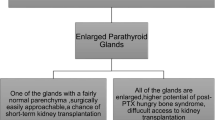Summary
Between 1969 and April 1975 24 patients with severe secondary hyperparathyroidism (sHPT) clinically presenting with uremic osteopathy required either total (n = 5) or subtotal (n = 18) parathyroidectomies. 17 patients were already supported by maintenance hemodialysis, 6 patients suffered from terminal renal insufficiency. The leading clinical symptoms consisted of general osteoporosis, spontaneous fractures, extraosseous calcifications and histologically proven dissecting fibroosteoclasia. After operation 18 patients experienced complete relief from their complaints and repair of their skeletal lesions, 2 patients required reexploration for an undetected hyperfunctioning 4th parathyroid gland, regretfully with no success. In 4 patients with subtotal parathyoidectomy a recurrence of varying intensity with increased PTH-secretion from the remnant had to be registered after months and years. — The indication for surgical treatment of sHPT due to chronic renal failure has to be based on two sets of finding:
-
1)
inadequate longterm suppression of increased PTH secretion by conservative measures like high dialysate calcium concentration or oral calcium intake, serum phosphorus depletion by oral intake of aluminium hydroxyde and possibly also by Vit. D;
-
2)
persistent hypercalcemia, progressive osteodystrophy and severe complaints like bone pain and pruritus.
Zusammenfassung
Im Zeitraum von 1969 bis April 1975 wurden 24 Patienten wegen eines sekundären Hyperparathyreoidismus mit ausgeprägter Ostitis fibrosa subtotal bzw. total parathyreoidektomiert. 17 Patienten standen unter Dauerdialyse, die übrigen befanden sich noch in der kompensierten Retention. Es handelte sich uneingeschränkt um schwere destruierende Knochenveränderungen, teilweise mit Spontanfrakturen, sowie um häufig massive extraossale Verkalkungen. Die präoperative Diagnostik umfaßte den eingehenden Röntgen-status des Skelets und die Beckenkammbiopsie. 1/3 der Patienten wies zusätzlich als weiteres, die Entscheidung zur chirurgischen Therapie stützendes Kriterium, eine persistierende Hypercalcämie auf. 18 Patienten wurden subtotal, 5 total parathyreoidektomiert. Bei 4 nicht radikal operierten Patienten mußten wir nach 4monatigen Verlaufskontrollen ein Rezidiv feststellen, zweimalig erfolgte Nachoperation. Die verbleibenden erfolgreichen Operationen führten uneingeschränkt in angemessenem Zeitraum zur Rückbildung der Auswirkungen des sHPT. Unseres Erachtens ist die Operationsindikation gegeben, wenn
-
1.
unbeherrschbare Knochenschmerzen und unstillbarer Pruritus das subjektive Wohlbefinden des Patienten erheblich beeinträchtigen,
-
2.
Spontanfrakturen auftreten,
-
3.
trotz Phosphatenentzugs zunehmende extraossale Verkalkungen nachweisbar werden,
-
4.
die Röntgenuntersuchungen des Skelets und die Spongiosa-Histologie übereinstimmend das Vorherrschen einer dissezierenden Fibroosteoklasie bestätigen und
-
5.
eine persistierende Hypercalcämie vorhanden ist.
Voraufgehend zu fordern bleibt unabdingbar eine adäquate konservative Behandlung über einen ausreichend langen Zeitraum. Nur wenn das Bemühen der sog. „achemischen Parathyreoidektomie” versagt, ist der operative Weg einzuschlagen.
Similar content being viewed by others
Literatur
Berson, S. A., Yalow, R. S.: Parathyroid hormone in plasma in adenomatous hyperparathyroidism, uraemia and bronchogenic carcinoma. Science154, 907 (1966)
Brickman, A. S., Coburn, J. W., Norman, A. W.: Action of 1,25-dihydroxy-cholecalciferol, a potent, kidney-produced metabolite of vitamin D, in uremic man. New Engl. J. Med.287, 891–895 (1972)
Gittes, R. F., Radde, I. C.: Experimental model for hyperparathyroidism: effect of excessive numbers of transplanted isologous parathyroid glands. J. Urol. (Baltimore)95, 595–603 (1966)
Goldsmith, R. S., Johnson, W. J., Arnaud, C. D.: The hyperparathyroidism of renal failure: Pathophysiology and treatment. In: Clin. Endocr. Metab.3, 305–321 (1974)
Johnson, W. J., Goldsmith, R. S., Beabout, J. W., Jowsey, J., Kelly, P. J., Arnaud, C. D.: Prevention and reversal of progressive secondary hyperparathyroidism in patients maintained by hemodialysis. Amer. J. Med.56, 827–832 (1974)
Katz, A. L.: The place of subtotal parathyroidectomy in the management of patients with chronic renal failure. Trans. Amer. Soc. Art. Org.14, 376–384 (1968)
Kleeman, C. R., Better, O., Massry, S. G., Maxwell, M. H.: Divalent ion metabolism and osteodystrophy in chronic renal failure. Yale J. Biol. Med.40, 1 (1967)
Lumb, G. A., Mawer, E. B., Stanbury, S. W.: The apparent vitamin D resistance in chronic renal failure. Amer. J. Med.50, 421 (1971)
Parfitt, A. M., Massry, S. G., Winfield, A. S., DePalma, J. R., Gordon, A.: Disordered calcium and phosphorus metabolism during maintenance hemodialysis. Amer. J. Med.51, 319 (1971)
Potts, J. T., Jr., Reitz, R. E., Deftos, L. J., Kaye, M. D., Richardson, J. A., Buckle, R. M., Aurbach, G. D.: Secondary hyperparathyroidism in chronic renal disease. Arch. intern. Med.124, 409 (1969)
Purnell, D. C., Smith, L. H., Scholz, D. A., Elveback, L. R., Arnaud, C. D.: Primary hyperparathyroidism. A prospective clinical study. Amer. J. Med.50, 639 (1971)
Reiss, E., Canterbury, J. M. Genesis of hyperparathyroidism. Amer. J. Med.50, 679 (1971)
Ritz, E.: Experimentelle Untersuchungen zum intestinalen Calciumtransport bei Urämie. Z. ges. exp. Med.152, 313 (1970)
Ritz, E., Malluche, H. H., Röher, H. D., Krempien, B., Koch, K. M., Andrassy, K.: Aktuelle Probleme der subtotalen Parathyroidektomie bei Hämodialyse-Patienten. Dtsch. med. Welt98, 484–496 (1973)
Röher, H. D., Wahl,-R.: Indikation und Behandlungsresultate der operativen Behandlung des sekundären Hyperparathyreoidismus bei chronischen Hämodialyse-Patienten. 75. Kongreß der Italienischen Chirurgen-Gesellschaft, Mailand 1973
Roth, S. J.: Recent advances in parathyroid gland pathology. Amer. J. Med.50, 612 (1971)
Slatopolsky, E. Caglar, S. Penell, J. P. Taggart, D. D. Canterbury, J. M. Reiss, E. Bricker, N. S. On the pathogenesis of hyperparathyroidism in chronic experimental renal insufficiency in the dog. J. clin. Invest.50492–499 (1971)
Stanbury, S. W. Azotaemic renal osteidystrophy. In: Clin. Endocr. Metab.1 I (1972)
St.Goar, W. T.: Case records of the Mass. Gen. Hosp. New Engl. J. Med.268, 943–953 (1963)
Williams, E. D.: Pathology of the parathyroid glands. In: Clin. Endocr. Metab.3, 285–303 (1974)
Wilson, R. E., Bernstein, D. S., Murray, J. E.,Moore, F. D.: Effects of parathyroidectomy and kidney transplantation on renal osteodystrophie. Amer. J. Surg.110, 384 (1965
Author information
Authors and Affiliations
Rights and permissions
About this article
Cite this article
Röher, H.D., Wahl, R. Chirurgische Aspekte des regulativen Hyperparathyreoidismus infolge Niereninsuffizienz. Langenbecks Arch Chiv 343, 23–33 (1976). https://doi.org/10.1007/BF01261567
Received:
Issue Date:
DOI: https://doi.org/10.1007/BF01261567




